Modular: Three Viking Age Supplements and One Role-Playing Game
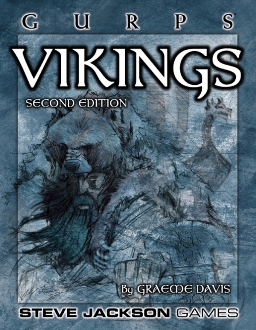 When I first discovered the Yggdrasill roleplaying game, I had the understanding that that Vikings-specific system existed in near-isolation. Oh how wrong I was! As I have purchased, downloaded and read Norse-themed rpg materials from DriveThruRPG and other sites, I have discovered that interest in the Northern ethos has been quite lively for some time. When, either out of mere curiosity or out of design to add to my home game, I first thought to collect Viking Age supplements, my mind naturally went to I.C.E.’s Vikings supplement for both Rolemaster and the Hero System: this was because, in my coming-of-age in the late 80s/early 90s, I was an ardent GM of MERP (Middle-Earth Role Playing, a scaled-down version of the Rolemaster rules set) and passionate about the Hero System in the form of Champions, a super-hero roleplaying game. But in those years, a young gamer with limited funds, I never could justify a pragmatic purpose for purchasing the I.C.E. Vikings supplement.
When I first discovered the Yggdrasill roleplaying game, I had the understanding that that Vikings-specific system existed in near-isolation. Oh how wrong I was! As I have purchased, downloaded and read Norse-themed rpg materials from DriveThruRPG and other sites, I have discovered that interest in the Northern ethos has been quite lively for some time. When, either out of mere curiosity or out of design to add to my home game, I first thought to collect Viking Age supplements, my mind naturally went to I.C.E.’s Vikings supplement for both Rolemaster and the Hero System: this was because, in my coming-of-age in the late 80s/early 90s, I was an ardent GM of MERP (Middle-Earth Role Playing, a scaled-down version of the Rolemaster rules set) and passionate about the Hero System in the form of Champions, a super-hero roleplaying game. But in those years, a young gamer with limited funds, I never could justify a pragmatic purpose for purchasing the I.C.E. Vikings supplement.
That situation has changed, now that I’m older and I have extra cash, but I still don’t have that I.C.E. supplement. The reason? Because it’s out of print and only available in hard copy via third party purveyors. The process of obtaining this seems like needless trouble when there are so many instant-gratification products available as immediate PDF downloads.
Today I will be reviewing, in the order in which I discovered and read them, three of these: GURPS Vikings, Troll Lord Games’s Codex Nordica, and Vikings of Legend for the Legend RPG System. All three of these seek to evoke a Viking Age roleplaying experience while using an existing rules set, the second type that I outline in my last post. I’ll say at the outset, though, that Codex Nordica read a lot like Vidar Solaas’s Vikings RPG, and I’m certain this is because of the similarity of the two systems that were being adapted for the Viking Age feel. Both Solaas’s D20 system and Brian N. Young’s Castles and Crusades engine have their foundations in Dungeons & Dragons, which has enjoyed so many iterations now that most of them aren’t even called Dungeons & Dragons anymore. Last post I allowed Solaas the distinction of having created an “original” Old Norse game, since he had to “hack” the D20 system so much. I’m tempted to award Young this same distinction, since in my view he visibly wrestled with many of the inflexibilities that I perceive in D&D games. But ultimately it belongs in the rpg supplement group; the following observation shares only one reason for this designation.
All three of these works exist alongside other “culture-specific” supplements. The GM then can choose to run a campaign using her campaign setting of choice alone, as well as the core rules of the system it was designed for, or include the material with other campaign books, hence creating a larger “world.”
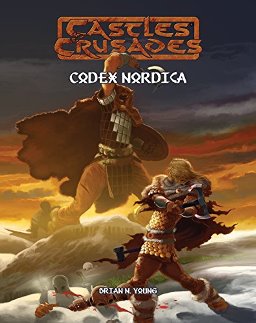 I am now getting quite used to a regular format for these books and the transmission of remarkably similar material through slightly different lenses. While I read these, the hyper-vigilant “nerd” in me gets quite caught up in the minutia of differences of interpretation among many of the works in regard to “authentic” Viking culture, particularly in reference to magic and the supernatural (of which I said more last post). But since a nit-picking comparative analysis would be exhausting both for you, the reader, and for me, I think I will confine this post to highlights of what stands out from these three supplements. In other words, I will be pointing to what I love and use or hope to use in my home game of choice, the Yggdrasill system.
I am now getting quite used to a regular format for these books and the transmission of remarkably similar material through slightly different lenses. While I read these, the hyper-vigilant “nerd” in me gets quite caught up in the minutia of differences of interpretation among many of the works in regard to “authentic” Viking culture, particularly in reference to magic and the supernatural (of which I said more last post). But since a nit-picking comparative analysis would be exhausting both for you, the reader, and for me, I think I will confine this post to highlights of what stands out from these three supplements. In other words, I will be pointing to what I love and use or hope to use in my home game of choice, the Yggdrasill system.
GURPS Vikings (2nd edition), by Graeme Davis, is an impressive and professional publication with few typos and many engaging illustrations. It was the first outside resource that I picked up, and it might be for this reason that it has the distinction of having material on the exterior of my home-built GM screen. This material is two charts titled “Viking Proverbs” and “Dying Well,” two charts that my players would do well to be pondering and meditating on throughout every game session. Of interest is its magic system, which is wide open. In short, players explain to the GM what magical effects they are trying to accomplish through use of the Runes, the GM assigns a difficulty, and away one goes — very intuitive, very flexible. It also has really good maps of a Viking longhouse and, much like Vikings of Legends which I shall write about third, great ideas for adventures and campaigns.
Brian N. Young’s Codex Nordica is designed for Castles and Crusades, and, as I’ve already suggested, wrestles with the limitations set on Nordic emulation through use of a traditional D&D rules set. Like Solaas with Vikings RPG, however, for the most part Young appears successful in evoking the Viking feel. In at least one regard, though, Young departs from any of the other supplements I’ve read so far by attempting to give some specific descriptions of each of the Nine Nordic Worlds as playable regions in their own right rather than consigning the campaign setting wholly to a “real-world” Scandinavian landscape. Young provides a great system for Rune magic. What I find most useful for my home game, however, are Young’s detailed descriptions of Norse battle methods in the chapter “Warriors and Battlecraft.” Young’s passion for his sources also comes stridently through, for in none of my other supplements have I seen someone go on so at length about Norse poetic forms and the importance of the GM and players reading Nordic literature for inspiration for a truly Nordic campaign. Young even provides a useful breakdown of the Poetic Edda, which, for the uninitiated, can be a bewildering work. Castles and Crusades’s Codex Nordica is a full-color (neither GURPS Vikings nor Vikings of Legend are) lavishly illustrated, professional publication occasionally marred with typos.
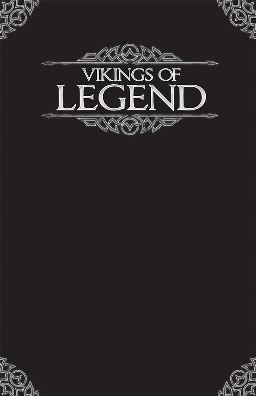 But if I were giving an award for what has been most useful for me, it would be Pete Nash’s Vikings of Legend for the Legends rpg system. Why is this? In a word, tables! I had been laboring at my own random name generation table before I thought to look at this supplement. With a few die rolls, a GM can generate a name out of 500 male names or 200 female names. There also is a table with 600 nicknames. In my last session I found myself regretting that I hadn’t included in my GM screen a table for randomly generating weapon names, also included in this publication. This supplement also, it seems to me, gave me the most details about daily Viking life and living situations in a way that I feel thoroughly confident in roleplaying out. Moreover, though many supplements stress the importance of Viking engagement in trade rather than in Northerner reputation for plunder, Vikings of Legend was the only work so far that actually provided a table of chief Scandinavian exports and desired imports and from where — very useful when a GM is constructing specific needs for an adventure.
But if I were giving an award for what has been most useful for me, it would be Pete Nash’s Vikings of Legend for the Legends rpg system. Why is this? In a word, tables! I had been laboring at my own random name generation table before I thought to look at this supplement. With a few die rolls, a GM can generate a name out of 500 male names or 200 female names. There also is a table with 600 nicknames. In my last session I found myself regretting that I hadn’t included in my GM screen a table for randomly generating weapon names, also included in this publication. This supplement also, it seems to me, gave me the most details about daily Viking life and living situations in a way that I feel thoroughly confident in roleplaying out. Moreover, though many supplements stress the importance of Viking engagement in trade rather than in Northerner reputation for plunder, Vikings of Legend was the only work so far that actually provided a table of chief Scandinavian exports and desired imports and from where — very useful when a GM is constructing specific needs for an adventure.
Another reason I might have enjoyed this supplement so much is because of its manner of conveyance. I read all three of these in PDF format on my iPad. Whereas GURPS Vikings and Castles and Crusades’s Codex Nordica, in my impression, appear formatted for print publication, Vikings of Legend might have been arranged with e-readers solely in mind. As such, even though unlike the other two publications Vikings of Legend was light on artwork (just check out that uninspiring cover), it is highly readable through its smaller word count per page, plenty of white space and a single column only.
There are many, many other Viking supplements to cover. I know that some readers of this website quite naturally will be crying out, “But what about AD&D’s HR1 Vikings Campaign Sourcebook!” Yes, yes, if my curiosity and enthusiasm continues unabated, I trust I shall get to that and many others in time, but before then my interest quite naturally turns to the few “complete” Viking Age rpgs that I have run across. My interest in looking at these is to see, as with the supplements, what material I might take from them to add to my game of choice, and to see what they do mechanically to best emulate the Viking atmosphere. After all, these Vikings games are completely unrestricted from an adherence to a pre-existing rules set. How do they do it in contradistinction to Yggdrasill?
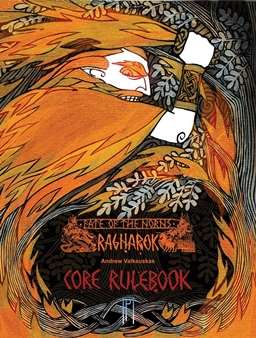 The most visible of these other rpgs is Andrew Valkauskas’s Ragnarok: Fate of the Norns, a game I was quite surprised to learn has been around, in one form or another, since 1993! According to Wikipedia, however, the game didn’t always boast its most interesting feature: the “Runic Game System.” If I thought Yggdrasill was innovative in using Runes as a mechanic in its game, I have to be more impressed with Fate of the Norns: since 2005 Valkauskas has already been going one better by making Runes the basis of all his mechanics. In short, the abilities of player characters (called “Dwellers” in this game) are determined by how many of each “type” of Nordic Runes they have, eight runes each organized into “Physical, Mental, and Spiritual.” During play, these runes are drawn out of rune-bags and placed on individual player mats to accomplish tasks and to resolve combat situations. The GM (called the “Norn”) also has a play mat and a bag of runes for each of his NPCs.
The most visible of these other rpgs is Andrew Valkauskas’s Ragnarok: Fate of the Norns, a game I was quite surprised to learn has been around, in one form or another, since 1993! According to Wikipedia, however, the game didn’t always boast its most interesting feature: the “Runic Game System.” If I thought Yggdrasill was innovative in using Runes as a mechanic in its game, I have to be more impressed with Fate of the Norns: since 2005 Valkauskas has already been going one better by making Runes the basis of all his mechanics. In short, the abilities of player characters (called “Dwellers” in this game) are determined by how many of each “type” of Nordic Runes they have, eight runes each organized into “Physical, Mental, and Spiritual.” During play, these runes are drawn out of rune-bags and placed on individual player mats to accomplish tasks and to resolve combat situations. The GM (called the “Norn”) also has a play mat and a bag of runes for each of his NPCs.
Like Young’s Codex Nordica, Valkauskas details each of the Nine Worlds, but he goes quite a bit further. Unlike Codex Nordica, which gives some suggestive details only, Fate of the Norns provides evocative maps for each of the worlds. In some ways, this difference is inevitable. All of the supplements that I have mentioned so far provides some discussion about what kind of a campaign that a GM might desire to run with Nordic material. Without splitting hairs, these campaigns break down into three general types: the historical, the mythic historical (the myths and tales of the supernatural are “real” but don’t intrude all that much into the “natural” world, with the exception, perhaps, of the use of magic), and the truly mythic. Kind of like my game of choice Yggdrasill, Fate of the Norns details Midgard and the rest of the worlds for a campaign setting. Unlike Yggdrasill, however, I would hazard that Fate of the Norns’s campaign setting is essential for the proper running of the game. Yggdrasill’s “Scandia” strikes me as a fairly generic setting for a Scandinavian alternate history. Fate of the Norns is something else entirely, something more like Walt Simonson’s current Ragnarok, and this is because it wholly absorbs itself into the myths of the Norse.
Fate of the Norns takes place after the Norse Ragnarok. To be specific, the Dwellers dwell in the Fimbul-winter — all is ice and all is dead. This setting is apocalyptic, to say the least, and very, very dark. The mythic enters here because the war of Ragnarok is still to be resolved, and it’s still uncertain who, ultimately, is going to be the victor. The Dwellers, then, are being bred for in death either Odin in Valhalla or Odin’s enemy Surt in Glassisvellir. 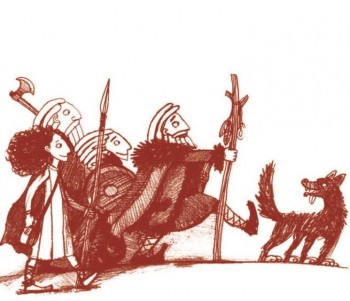 This imperative introduces yet one more intriguing mechanic: Dweller death is an inevitable and, in some ways, valued part of the game. When a Dweller dies, the player then makes another, and this Dweller is considered to be a descendant of the other Dweller and gets some mechanical advantages at character creation. The more Dwellers that “die” and pass on to Valhalla or Glassisvellir, the more advantages the next Dweller gets, and a richer backstory truly worthy of a saga!
This imperative introduces yet one more intriguing mechanic: Dweller death is an inevitable and, in some ways, valued part of the game. When a Dweller dies, the player then makes another, and this Dweller is considered to be a descendant of the other Dweller and gets some mechanical advantages at character creation. The more Dwellers that “die” and pass on to Valhalla or Glassisvellir, the more advantages the next Dweller gets, and a richer backstory truly worthy of a saga!
Aspects of this game raise some questions, however. By necessity, Valkauskas appears to play fairly loose with the “canon” of Norse mythology in his construction of his apocalyptic campaign setting, in some cases devising key, important figures out of a mere mention or kenning in the Eddas. Moreover, something that is at odds with the tone of this game, at least in this latest edition, is the artwork. Don’t get me wrong: the artwork is great! And this product truly is a sumptuous, illustrated feast. Every single page is, I would say, on average more color and art than text, quite the departure from your average rpg manual and, like Vikings of Legend, easily readable in PDF. And the art is fitting for the Norse ethos insofar as it is folksy and patterned. But most of the figures are rendered as cutesy cartoons rather than formidable and grim Viking monsters and warriors. I am speaking about the Core Rulebook and, judging by the covers, the two sourcebooks Denizens of the North and Fafnir’s Treasure, not the quite different Illuminated Edda that I’m absolutely salivating over.
Some readers might recall the four questions that I bring to these reviews of Viking supplements and roleplaying games. In the case of this last I will jump right to the fourth question: do I want to play this game? Oh, yes! Someone bring it to a con I’m attending! Please! Can I run it in my home game? Probably not. The mechanics might be too innovative, and the time requirement to make full use of Dweller death quite daunting.
What a pleasant surprise. Thank you!
Happy to make it, Pete! Vikings of Legends is a usable and well-written tome full of useful gaming details that the others don’t similarly provide. Another example I can think of is your observation that a typical farmstead supported about 20 adults. The little things, I know, but really accessible information
I was going to ask if you would cover RuneQuest Vikings, but you did in a way (Legend). The old RuneQuest (Avalon Hill) Vikings was well respected in its day. Other suggestions if you have appetite are:
Rune – RPG based on a computer game of same name. By Atlas Games
Ivinia. – setting for Hârnworld. Long out of print though so can be a bit tricky to obtain.
Cool article by the way never even heard of Fate of Norms before.
Thanks for the recommendations, Tiberius. So, a quick Internet search suggests that Legend rpg system is the same or related to Runequest/Runequest II?
Rune tabletop certainly is intriguing, written by one Robin Laws. I recognize that name… ?
Correct Gabe. Mongoose RuneQuest II was rebranded as Legend. The Design Mechanism took over the brand and produced a revised version (RQ6) which has subsequently been renamed Mythras. So one can own 4 separate games which are all ostensibly the same.
Hey Gabe, Avalanche Press did some themed supplements for Third Edition. ‘Greenland Saga: The Lost Norse Colony,’ ‘Ragnarok’ and ‘Doom of Odin’ (sequel to Ragnarok).
Have you seen those? Not great, but they do have Viking/Nordic content and worth checking out for material, probably.
Thanks for the note, Bob. These look fun. I have to grin at the “pin-up” art on each of these covers. Done by a Heavy Metal artist; definitely a Heavy Metal conception of Northerners and their gods!
Yeah – Avalanche specifically went for the cheesecake designs on their RPG stuff. The president even talks about the models they used at the website.
They’re actually a war game company that took an RPG detour during 3rd Edition.